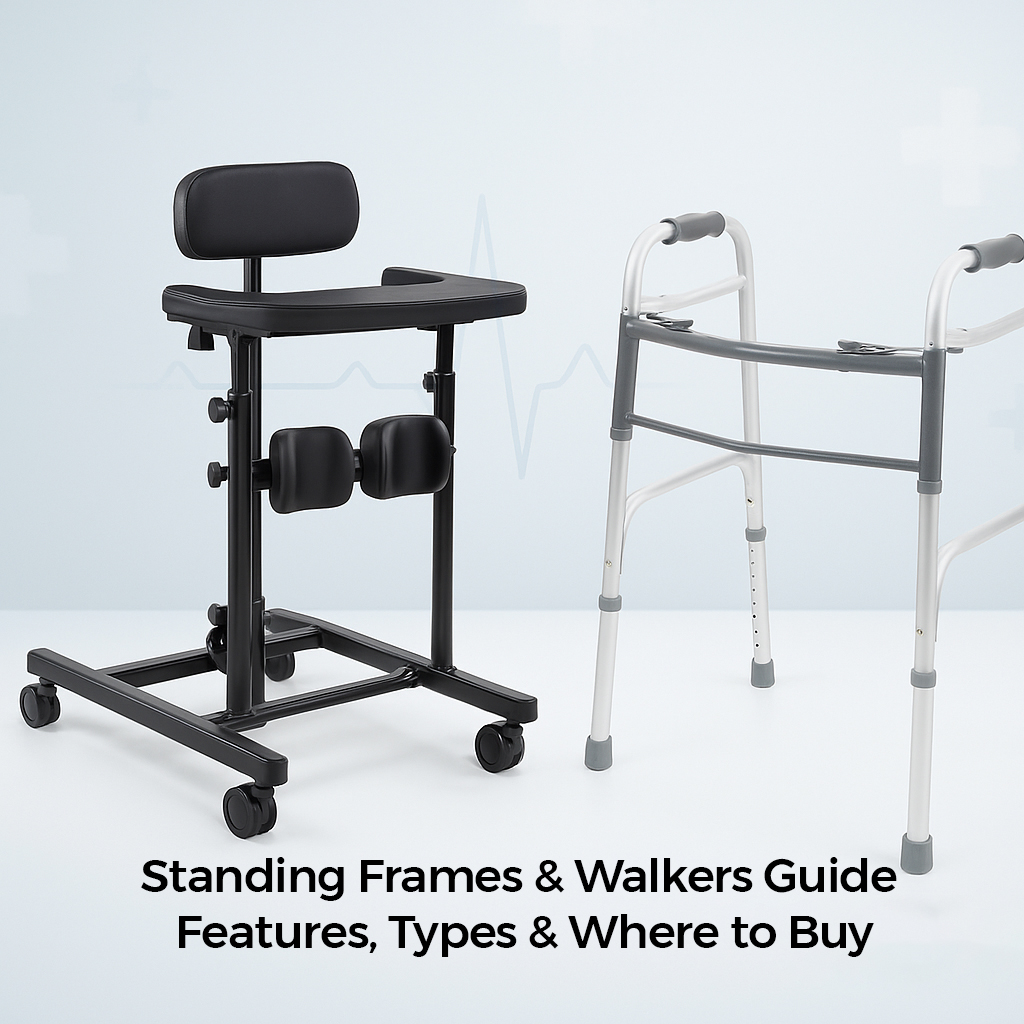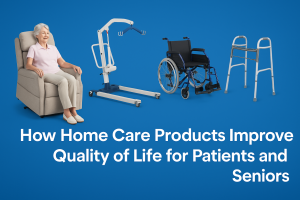Mobility challenges can make everyday tasks more difficult, but the right assistive device can restore both independence and confidence. Standing frames and walkers are two essential mobility aids that help users maintain posture, improve movement, and enhance overall quality of life.
A standing frame is designed to support a person in an upright position, allowing them to stand safely even if they have limited or no ability to do so on their own. This is particularly helpful for rehabilitation, improving circulation, and reducing the risk of muscle contractures.
On the other hand, walkers provide stability and support while walking. They are ideal for people recovering from surgery, living with disabilities, or experiencing balance issues due to age or medical conditions.
In this guide, we’ll explore the benefits, types, and key features of standing frames and walkers. By the end, you’ll know exactly what to look for and where to buy so you can choose the mobility aid that’s best suited to your needs.
Benefits of Using Standing Frames & Walkers
Standing frames and walkers offer more than just physical support they can significantly improve health, independence, and quality of life. Whether used at home, in rehabilitation centers, or as part of daily mobility, these aids have long-term benefits for users of all ages.
1. Improved Posture and Balance
By supporting the body in an upright position, standing frames help align the spine, strengthen muscles, and improve overall balance. This can reduce the risk of falls and related injuries.
2. Reduced Risk of Secondary Health Problems
Prolonged sitting can lead to poor circulation, joint stiffness, and muscle weakening. Standing frames promote weight-bearing, which helps in maintaining bone density and improving cardiovascular health.
3. Increased Independence
For many users, a walker provides the freedom to move around without constant assistance from others. It allows them to engage in daily activities, whether at home or outdoors.
4. Physical and Emotional Wellbeing
Mobility aids not only enhance physical movement but also boost self-confidence. Standing frames and walkers encourage social interaction and participation in activities, improving emotional health.
In the UAE, many healthcare providers include these products as part of their recommended medical equipment in the UAE range, ensuring patients have access to the right mobility support tailored to their needs.
Types of Standing Frames
Standing frames come in various designs to meet different medical, rehabilitation, and daily living needs. Choosing the right type depends on the user’s mobility level, physical condition, and intended usage.
1. Static Standing Frames
These remain fixed in one place and provide stable, long-term standing support—ideal for therapy sessions or daily posture correction exercises.
2. Mobile Standing Frames
Fitted with wheels, these frames allow movement while standing, giving users more flexibility during rehabilitation or light activities.
3. Prone Standing Frames
Designed for users who lean forward slightly, these are often used for strengthening back and leg muscles.
4. Supine Standing Frames
Providing back support, these are suitable for individuals who require extra stability due to weak trunk control.
5. Convertible Standing Frames
These versatile designs can be adjusted to both sitting and standing positions, making them ideal for multipurpose use in home care product settings.
Types of Walkers
Walkers are designed to offer stability, improve mobility, and reduce the risk of falls. They come in different types to suit a variety of users, from elderly individuals to those recovering from injuries or surgeries.
1. Standard Walkers
These have four legs and no wheels, providing maximum stability. They are best for short distances and indoor use.
2. Rollator Walkers
Equipped with three or four wheels, these allow smoother movement and often include a built-in seat for resting.
3. Knee Walkers
An alternative to crutches, these are ideal for individuals recovering from foot or ankle injuries.
4. Upright Walkers
These feature a higher handlebar design that encourages better posture and reduces strain on the back.
5. Pediatric Walkers
Specially designed for children, often with colorful frames and adjustable heights. Some pediatric rehabilitation programs may pair walkers with pushchairs & strollers to provide flexible mobility options for younger users.
Key Features to Look for Before Buying
Before purchasing a standing frame or walker, it’s important to focus on features that ensure comfort, durability, and safety.
1. Adjustability and Height Settings
A device with adjustable height ensures proper posture and reduces strain on the arms and back.
2. Frame Material and Durability
Aluminum and steel frames are common choices. Aluminum is lightweight, while steel offers maximum strength.
3. Weight Capacity
Always check the weight limit to make sure the product can safely support the user.
4. Portability and Storage
Foldable designs are ideal for users who need to travel or store the equipment in small spaces.
5. Safety Features
Non-slip grips, locking brakes, and sturdy wheels add an extra layer of security. In some cases, users may also require complementary aids like commode and shower chairs for added convenience in daily routines.
How to Choose the Right Standing Frame or Walker for Your Needs
Selecting the right mobility aid depends on your lifestyle, medical condition, and personal preferences. Here are a few points to consider:
1. Considering Age & User Mobility Level
Younger users may require more adjustable and lightweight models, while older adults might prefer heavier, more stable options.
2. Indoor vs Outdoor Use
For indoor use, compact designs work best, while outdoor use may require larger wheels and stronger frames.
3. Budget Considerations
Set a realistic budget that balances affordability with long-term durability.
4. Medical Advice & Physiotherapy Recommendations
Always consult with a healthcare provider or physiotherapist before purchasing to ensure the product matches your rehabilitation goals.
For individuals with limited mobility, pairing these aids with wheelchairs can provide comprehensive support both indoors and outdoors.
Maintenance & Safety Tips
To ensure your standing frame or walker remains safe and effective, regular care is essential.
1. Cleaning and Care Instructions
Wipe down metal and plastic parts with a mild cleaner to prevent dirt buildup. Avoid harsh chemicals that can damage surfaces.
2. Regular Safety Checks
Inspect bolts, screws, and joints regularly to ensure they’re secure. Check the condition of wheels and brakes for smooth operation.
3. When to Replace Parts
Replace worn-out grips, wheels, or straps immediately to maintain safety.
For users who rely heavily on mobility aids, especially those with more active lifestyles, an active wheelchair may also require similar maintenance routines to ensure durability and comfort over time.
Where to Buy Standing Frames & Walkers
Wahat Al Noor understands that finding the right mobility aid is about more than just buying a product; it’s about choosing quality, comfort, and reliability. Standing frames and walkers are available through a variety of trusted sources, and knowing where to shop can make all the difference.
1. Online Medical Equipment Stores
Our online platform offers detailed product descriptions, customer reviews, and easy comparison tools, making it simple to find the standing frame or walker that perfectly suits your needs.
2. Local Mobility Aid Shops
If you prefer to see and test products before purchasing, Wahat Al Noor also serves customers through physical locations, where you can try different models and receive guidance from our mobility specialists.
3. Buying Tips for Best Deals and Warranty
Always choose products that come with a warranty and dependable after-sales service. Wahat Al Noor, we ensure that every purchase is backed by quality assurance, giving you confidence in your investment.
Many of our stores also stock complementary mobility aids, such as manual wheelchairs, so you can find everything you need in one convenient place.
Conclusion
Standing frames and walkers are more than just mobility aidsthey are life-changing tools that promote independence, confidence, and overall health. Choosing the right model involves considering your specific needs, environment, and budget. Always prioritize comfort, safety, and durability, and don’t hesitate to seek medical advice before making a purchase.
In the UAE, there are plenty of trusted suppliers offering a variety of options, from basic walkers to advanced standing frames. Many also provide complementary solutions like power mobility devices, ensuring that every user can find the perfect combination of support and freedom.
When you invest in the right mobility aid, you’re not just buying a product, you’re unlocking greater independence and a better quality of life.
FAQs
Q1: How do I know which size standing frame or walker is right for me?
Measure your height and check the product’s adjustable range. A physiotherapist can also recommend the right fit based on your posture and mobility needs.
Q2: Can standing frames be used for children?
Yes. Pediatric standing frames are specifically designed with adjustable heights, safety harnesses, and colorful designs for younger users.
Q3: Are walkers covered by insurance or health programs?
In some cases, insurance providers or health schemes will cover part or all of the cost, especially if prescribed by a medical professional.
Q4: Can I use a walker outdoors?
Yes, but it’s best to choose a design with larger wheels for stability on uneven surfaces.
Q5: How does a foldable walker compare to other mobility aids?
Foldable walkers are more portable and easier to store, but for long-distance travel or more advanced needs, a foldable wheelchair might offer greater comfort and convenience.




